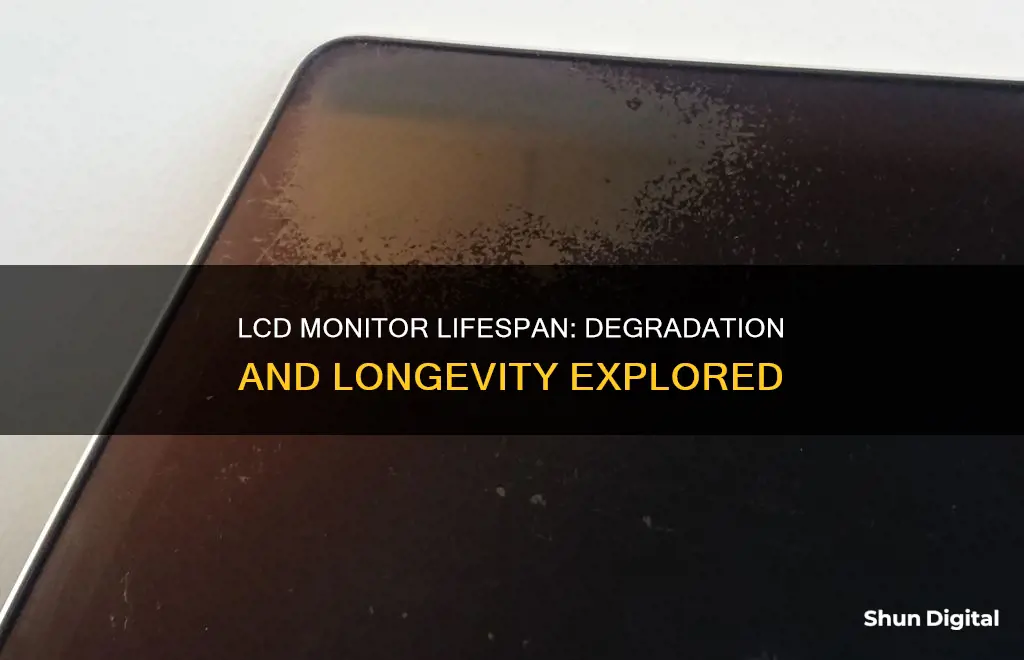
LCD monitors are known to lose brightness over time, though they do not illuminate on their own. Instead, they have a backlight that is usually a CFL bulb or a set of LEDs. The CCFL backlights in the monitors will degrade over time, causing the screen to become dimmer. This degradation happens slowly, so unless the monitor is left on 24/7 for an extended period, there shouldn't be a noticeable difference.
| Characteristics | Values |
|---|---|
| Do LCD monitors degrade over time? | The panel itself won't, but the backlight will if it's a fluorescent tube (which, most are). |
| How long does it take for an LCD monitor to degrade? | CCFL or lamp will slowly degrade over time. It can take a few years for this to happen. |
| How to slow down the degradation of an LCD monitor? | Running the LCD monitor at less brightness will extend its life. |
What You'll Learn
- LCD monitors can degrade over time due to the CCFL backlights losing brightness
- The cathode bulb can dim over time, lowering the screen's brightness
- The inverter can wear out, reducing the voltage and causing the screen to dim
- LCD monitors with fluorescent backlights will slowly get darker as the element degrades with age
- LED backlights may also lose brightness over time, but at a much slower rate

LCD monitors can degrade over time due to the CCFL backlights losing brightness
The rate at which CCFL backlights degrade depends on usage. If the monitor is left on 24/7, the backlight will degrade faster. Additionally, running the backlight at higher brightness settings will cause it to dim more quickly. However, even with high usage, the degradation is fairly slow, and it may take a few years before any significant loss of brightness is noticeable.
The effects of CCFL backlight degradation can be mitigated by replacing the backlight or adjusting the software settings to make the display appear brighter. Replacing the backlight is not a beginner task, but it is also not extremely difficult. Software adjustments can also help make the display appear brighter, but these adjustments may only have a limited effect.
It is worth noting that LED backlights, which are now more commonly used in LCD monitors, also lose brightness over time, but at a much slower rate than CCFL backlights. LED backlights are designed to last for many years, and the monitor is likely to become obsolete before the LED backlight needs to be replaced.
A Simple Guide to Remove Lines on Your ASUS Monitor
You may want to see also

The cathode bulb can dim over time, lowering the screen's brightness
The cathode bulb in an LCD monitor can dim over time, lowering the screen's brightness. This is due to the bulb degrading with use, which reduces its light-emitting qualities. While this degradation occurs slowly, it will result in a noticeable decrease in brightness over time.
The rate at which an LCD screen's brightness decreases is dependent on several factors, including usage and the type of backlight. LCD screens utilising fluorescent elements for backlighting, such as CCFL bulbs, will experience a gradual dimming over time. This is because the light-emitting qualities of fluorescent elements degrade with use. However, this degradation occurs at a slower rate compared to LED backlights, which have a shorter lifespan in terms of brightness.
The usage of an LCD monitor also plays a significant role in the dimming of the cathode bulb. The more a monitor is used, the faster the bulb will degrade and dim. Monitors that are left on continuously or are used for extended periods each day will exhibit faster degradation. Additionally, the initial brightness of an LCD screen can influence its lifespan, with newer screens that are brighter initially potentially having a shorter lifespan.
It is worth noting that while the cathode bulb can dim over time, the LCD panel itself typically does not degrade in the same way. The dimming of the bulb can be addressed by replacing it or adjusting the software settings to compensate for the loss in brightness. However, replacing the bulb may not be a straightforward task and is generally not recommended for inexperienced individuals.
To prolong the brightness lifespan of an LCD monitor, it is advisable to reduce the brightness settings and adjust them based on current lighting conditions. This can help extend the life of the cathode bulb and delay the onset of noticeable dimming. Additionally, utilising power-saving modes can aid in reducing the brightness output and conserving energy.
Fortnite Usage: Monitoring Your Child's Gameplay
You may want to see also

The inverter can wear out, reducing the voltage and causing the screen to dim
The inverter in an LCD monitor is responsible for supplying voltage to the screen, and it can wear out over time. This wear and tear lead to a reduction in the voltage output, which in turn causes the screen to become dimmer. The degradation of the inverter happens gradually and can take a few years, depending on the usage patterns of the LCD monitor.
The inverter plays a crucial role in maintaining the brightness of an LCD screen. When it starts to wear out, the voltage supplied to the screen decreases, resulting in a dimming effect. This issue is separate from the degradation of the cathode bulb, which is another factor that can contribute to an LCD screen becoming less bright over time.
The process of inverter degradation can vary in speed depending on the specific LCD model and its usage. In some cases, the inverter may be the first component to show signs of wear, while the cathode bulb remains functional. Replacing the inverter can be a complex task, ranging from challenging to extremely difficult, depending on the design of the LCD monitor.
It is worth noting that LCD monitors with fluorescent backlights are particularly susceptible to this issue. The degradation of the backlight can cause the screen to appear dimmer, and this effect can become noticeable after a few years of regular use. However, it's important to remember that LCD screens do not illuminate on their own; they rely on a backlight, which can be a CFL bulb or a set of LEDs.
While inverter degradation can cause the screen to dim, it is important to note that the overall lifespan of an LCD monitor is still relatively long. With average use, an LCD monitor can last for several years before showing significant signs of degradation. Additionally, advancements in technology often lead to newer models with improved brightness and vividness, making older LCD monitors appear less bright in comparison.
Monitoring Data Usage: A Guide to Tracking Globe-wide
You may want to see also

LCD monitors with fluorescent backlights will slowly get darker as the element degrades with age
The degradation of LCD monitors over time is a concern for many users. While the panel itself does not degrade, the backlight will if it is a fluorescent tube, which is the case for most LCD monitors. This means that LCD monitors with fluorescent backlights will slowly get darker as the element degrades with age.
The CCFL (cold cathode fluorescent lamp) backlights in LCD monitors will degrade and become dimmer over time. This degradation occurs slowly, so unless the monitor is left on 24/7 for extended periods, the loss of brightness may not be significant. Additionally, the inverter can "wear out", lowering the voltage and resulting in a dimmer screen. However, this typically takes several years, even with high usage.
The rate of degradation and dimming depends on the type of backlight used. Fluorescent backlit LCDs, such as those using CCFL tubes, will lose brightness over time. LED backlights also dim but at a much slower rate. The standard L70 for LED lighting targets 70% of initial maximum brightness after 50,000 hours, which translates to 5.7 years of continuous operation.
It is worth noting that advancements in technology have also contributed to the perceived dimming of older LCD monitors. Newer panels often offer improved brightness and colour quality, making older models appear dimmer and less vibrant in comparison.
To extend the lifespan of an LCD monitor, it is recommended to reduce the brightness setting and utilise power-saving features such as screen savers and auto-shutdown timers. These measures can help reduce the rate of degradation and maximise the usable life of the monitor.
Monitor Size for Office Workers: What's the Sweet Spot?
You may want to see also

LED backlights may also lose brightness over time, but at a much slower rate
While LCD screens don't illuminate on their own and require a backlight, it's important to distinguish between the two types of backlights: CFL bulbs and LED backlights. The CCFL or CFL bulbs will slowly degrade over time, becoming dimmer. However, LED backlights, which are now more commonly used, are known to have a much slower degradation rate in terms of brightness.
The L70 standard for LED lighting targets 70% of initial maximum brightness after 50,000 hours of use, which equates to 5.7 years if operated continuously. This slow degradation rate means that by the time your LED backlight starts to noticeably dim, the tech in your device will likely be obsolete and ready for an upgrade.
While LED backlights do dim over time with high usage, they are the most energy-efficient and long-lasting type of illumination available. Their longevity is due in part to the fact that they don't burn out like light bulbs; instead, their brightness gradually diminishes over an extended period. Additionally, running your device at lower brightness settings will help extend the life of your LED backlight.
In summary, while LED backlights in LCD monitors may lose brightness over time, the rate of degradation is much slower compared to other types of illumination. By the time your LED backlight starts to dim noticeably, you'll likely be ready for an upgrade to newer technology anyway.
IPS Monitors and LCDs: What's the Difference?
You may want to see also
Frequently asked questions
The panel itself won't degrade, but the backlight will if it's a fluorescent tube, which most are.
CCFL backlights in monitors will degrade over time, but they do so fairly slowly. It will take a few years for the monitor to noticeably dim unless you leave it on 24/7.
If you have two of the same model LCD monitors, one that's newer and one that's older, and you place them side by side, the older one will look significantly dimmer.
You can try to run your LCD monitor at less brightness. Running any component at a lower output will generally result in a longer life.







